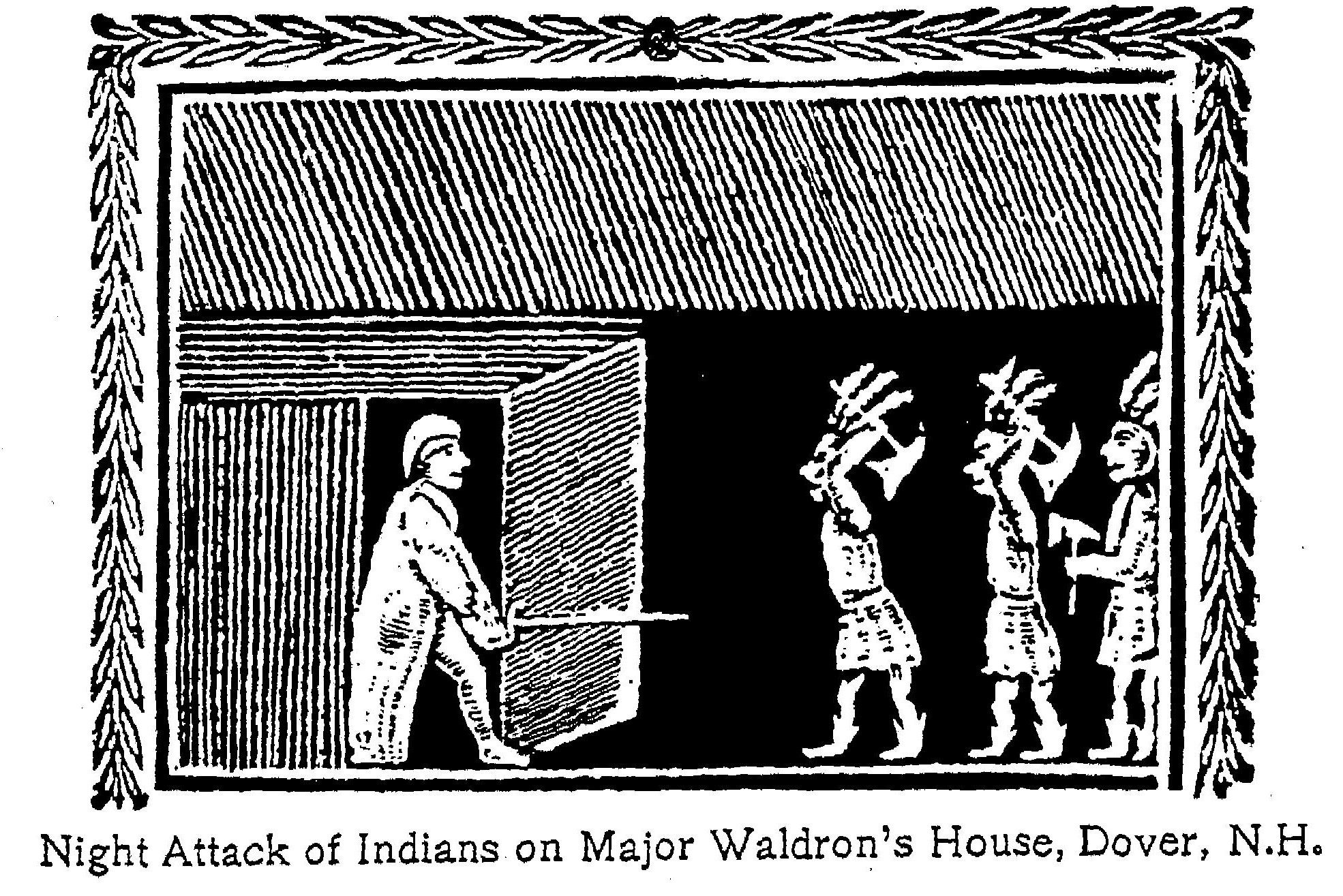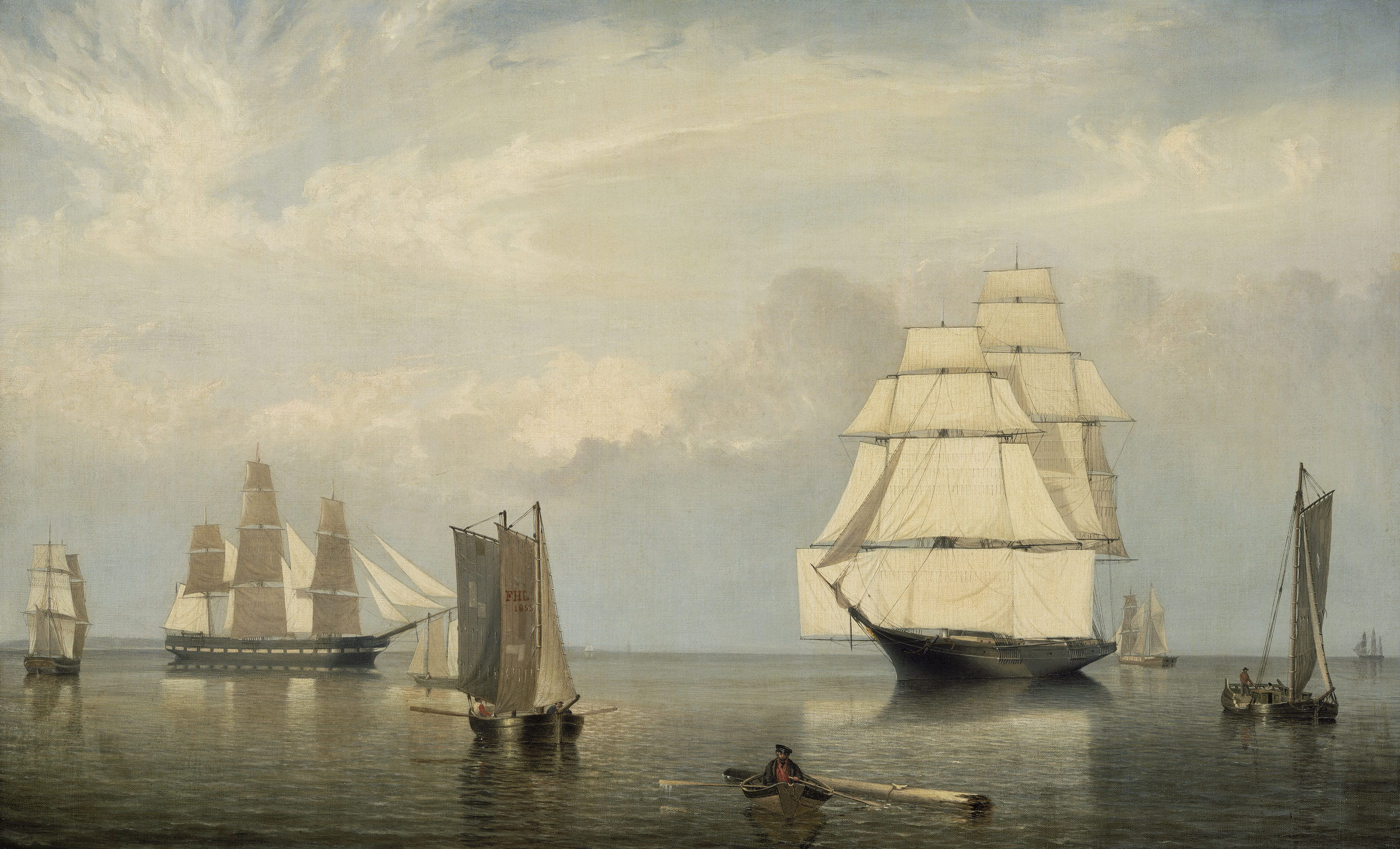|
First Abenaki War
The First Abenaki War (also known as the northern theatre of King Philip's War) was fought along the New England/Acadia border primarily in present-day Maine. Richard Waldron and Charles Frost led the forces in the northern region, while Jean-Vincent d'Abbadie de Saint-Castin worked with the tribes that would make up the Wabanaki Confederacy. The natives engaged in annual campaigns against the English settlements in 1675, 1676, and 1677. Waldron sent forces so far north that he attacked the Mi'kmaq in Acadia. Historian Georges Cerbelaud Salagnac writes that Castine and the Abenaki "displayed consummate skill at it, holding in check at every point, from the Penobscot River to Salmon Falls, N.H., and even beyond, 700 regular troops, and even inflicting humiliating defeats upon them." The official records indicate natives killed or captured 260 English. The villages of Cape Neddick, Scarborough, Casco, Arrowsick, Pemaquid and several others were destroyed. The war cost the colo ... [...More Info...] [...Related Items...] OR: [Wikipedia] [Google] [Baidu] |
King Philip's War
King Philip's War (sometimes called the First Indian War, Metacom's War, Metacomet's War, Pometacomet's Rebellion, or Metacom's Rebellion) was an armed conflict in 1675–1678 between a group of indigenous peoples of the Northeastern Woodlands against the English New England Colonies and their indigenous allies. The war is named for Metacom (alternatively Metacomet), the Pokanoket chief and sachem of the Wampanoag who had adopted the English name Philip because of the friendly relations between his father Massasoit and the Plymouth Colony. The war continued in the most northern reaches of New England until the signing of the Treaty of Casco Bay on April 12, 1678. Massasoit had maintained a long-standing agreement with the colonists and Metacom (), his younger son, became the tribal chief in 1662 after his father's death. Metacom, however, forsook his father's alliance between the Wampanoags and the colonists after repeated violations by the latter. The colonists insist ... [...More Info...] [...Related Items...] OR: [Wikipedia] [Google] [Baidu] |
Arrowsic, Maine
Arrowsic is a town in Sagadahoc County, Maine, United States. The population is 477 as of the 2020 United States census. It is part of the Portland-South Portland-Biddeford metropolitan area. During the French and Indian Wars, Arrowsic was site of a succession of important and embattled colonial settlements. It is a favorite with artists and birdwatchers. History The Abenaki people called the island Arrowseag, meaning "place of obstruction," a reference to Upper Hell Gate on the Sasanoa River. Until it was widened by the Army Corps of Engineers in 1898 and 1908, the stretch was choked with boulders and ledges. Indian canoe passage would have been risky in the swift current between Merrymeeting Bay and Sheepscot Bay. In 1649, John Richards purchased Arrowsic from the sachem Mowhotiwormet, commonly known as Chief Robinhood. Richards then sold it in 1654 to Major Thomas Clarke and Roger Spencer, the latter selling his share in 1657 to Captain Thomas Lake. Clarke and Lake were B ... [...More Info...] [...Related Items...] OR: [Wikipedia] [Google] [Baidu] |
William Phips
Sir William Phips (or Phipps; February 2, 1651 – February 18, 1695) was the first royally appointed governor of the Province of Massachusetts Bay, and the first native-born person from New England to be knighted. Phips was famous in his lifetime for recovering a large treasure from a sunken Spanish galleon but is perhaps best remembered today for establishing the court associated with the infamous Salem Witch Trials, which he grew unhappy with and was forced to prematurely disband after five months. Early life Phips was born the son of James and Mary Phips in a frontier settlement at Nequasset (present-day Woolwich, Maine), near the mouth of the Kennebec River, on February 2, 1651. His father died when the boy was six years old, and his mother married a neighbor and business partner, John White. Although Cotton Mather in his biography of Phips claimed that he was one of 26 children, this number is likely an exaggeration or includes many who did not survive infancy. His mother ... [...More Info...] [...Related Items...] OR: [Wikipedia] [Google] [Baidu] |
Merrymeeting Bay
Merrymeeting Bay is a large freshwater tidal bay located in the U.S. state of Maine. Merrymeeting Bay's unusual geography defies common landform terms. It is not what is usually meant by the word bay. It is somewhat like an estuary but it has fresh water with very little salt. Geologically it is described as an "inland delta" and biologically as "tidal riverine." The head of Merrymeeting Bay is generally considered to begin at the southernmost point of Swan Island. Bordering towns and cities include Bath, Brunswick, Topsham, Bowdoinham, Dresden, and Woolwich. Public access to the bay is gained mainly from public docks on one of the contributing rivers in Brunswick, Bath, Richmond, and Bowdoinham. Geology Six rivers flow into the bay, the two largest being the Kennebec River and the Androscoggin River. The four smaller rivers are the Cathance, Eastern, Abagadasset, and Muddy rivers. The bay receives water from nearly 40% of Maine's land area as well as from part of New Ha ... [...More Info...] [...Related Items...] OR: [Wikipedia] [Google] [Baidu] |
Sheepscot River
The Sheepscot River is a U.S. Geological Survey. National Hydrography Dataset high-resolution flowline dataThe National Map accessed June 22, 2011 river in the U.S. state of Maine. Its lower portion is a complex island estuary with connections to the Kennebec River downstream of Merrymeeting Bay. Route The Sheepscot River originates in Freedom () and flows southwesterly through Sheepscot Pond in Palermo and Long Pond in Somerville and Windsor. The river is bridged by Maine State Route 3 upstream of Sheepscot Pond and by Maine State Route 105 in Somerville between Sheepscot Pond and Long Pond. The river continues flowing southwesterly through the villages of Coopers Mills, North Whitefield, and Whitefield in the town of Whitefield. The river is bridged by concurrent Maine State Routes 17 and 32 at Coopers Mills. The West Branch Sheepscot River joins the main stem between Cooper's Mills and North Whitefield. The river is bridged by Maine State Route 126 at North Whitef ... [...More Info...] [...Related Items...] OR: [Wikipedia] [Google] [Baidu] |
Salem, Massachusetts
Salem ( ) is a historic coastal city in Essex County, Massachusetts, United States, located on the North Shore (Massachusetts), North Shore of Greater Boston. Continuous settlement by Europeans began in 1626 with English colonists. Salem was one of the most significant seaports trading commodities in Colonial history of the United States, early American history. Prior to the dissolution of county governments in Massachusetts in 1999, it served as one of two county seats for Essex County, alongside Lawrence, Massachusetts, Lawrence. Today, Salem is a residential and tourist area that is home to the House of Seven Gables, Salem State University, Pioneer Village (Salem, Massachusetts), Pioneer Village, the Salem Maritime National Historic Site, Salem Willows, Salem Willows Park, and the Peabody Essex Museum. It features historic residential neighborhoods in the Federal Street District and the Charter Street Historic District. [...More Info...] [...Related Items...] OR: [Wikipedia] [Google] [Baidu] |
Northeast Coast Campaign (1676)
The Northeast Coast campaign of 1676 took place during King Philip's War. It involved the Wabanaki Confederacy raiding colonial American settlements along the New England Colonies/Acadia border in present-day Maine. In the first month, they laid waste to 15 leagues (approximately ) of the coast east of Casco. They killed and captured colonists and burned many farms, blunting the tide of colonial American expansion. The campaign led colonists to abandon the region and retreat to Salem, Massachusetts. The campaign is most notable for Richard Waldron entering the war, the death of Chief Mog, and the attack on the Mi’kmaq that initiated their involvement in the war. Historical context Jean-Vincent d'Abbadie de Saint-Castin was ordered by the Governor of Quebec to organize all the natives "throughout the whole colony of Acadia to adopt the interests of the king of France." citing the "Mémoire des services rendus par les sieurs de Saint-Castin, père et fils, dans le pays de Ca ... [...More Info...] [...Related Items...] OR: [Wikipedia] [Google] [Baidu] |
Saco River
The Saco River ( , Abenaki: ''Sαkóhki'') is a river in northeastern New Hampshire and southwestern Maine in the United States. It drains a rural area of of forests and farmlands west and southwest of Portland, emptying into the Atlantic Ocean at Saco Bay, from its source.U.S. Geological Survey. National Hydrography Dataset high-resolution flowline dataThe National Map accessed June 30, 2011 It supplies drinking water to roughly 250,000 people in thirty-five towns; and historically provided transportation and water power encouraging development of the cities of Biddeford and Saco and the towns of Fryeburg and Hiram. Samuel de Champlain sailed a portion of the river in 1605 and referred to it as ''Chouacoet'', which he said was the name used by the Wabanaki Confederacy, Almouchiquois people. Various sources also give their name as "Sokoki" (a term also used for the Missiquoi people of western New England) and as being either the ancestors or close relatives of the ... [...More Info...] [...Related Items...] OR: [Wikipedia] [Google] [Baidu] |
Northeast Coast Campaign (1675)
The Northeast Coast campaign of 1675 was conducted during the First Abenaki War (the northern theatre of King Philip's War) and involved the Wabanaki Confederacy raiding colonial American settlements along the New England Colonies/Acadia border in present-day Maine. Allied with French colonists in New France, they killed eighty colonists and burned many farms, blunting the tide of colonial British expansion in the north. Settlers deserted community after community, leaving only the settlements south of the Saco River to maintain an English presence in the region. Historian Georges Cerbelaud Salagnac writes, that Castine and the Abenaki “displayed consummate skill at it, holding in check at every point, from the Penobscot River to Salmon Falls, N.H., and even beyond, 700 regular troops, and even inflicting humiliating defeats upon them.” These raids were part of continuing warfare as the French and British fought for control in North America into the 18th century, as part of the ... [...More Info...] [...Related Items...] OR: [Wikipedia] [Google] [Baidu] |
Boston
Boston is the capital and most populous city in the Commonwealth (U.S. state), Commonwealth of Massachusetts in the United States. The city serves as the cultural and Financial centre, financial center of New England, a region of the Northeastern United States. It has an area of and a population of 675,647 as of the 2020 United States census, 2020 census, making it the third-largest city in the Northeastern United States after New York City and Philadelphia. The larger Greater Boston metropolitan statistical area has a population of 4.9 million as of 2023, making it the largest metropolitan area in New England and the Metropolitan statistical area, eleventh-largest in the United States. Boston was founded on Shawmut Peninsula in 1630 by English Puritans, Puritan settlers, who named the city after the market town of Boston, Lincolnshire in England. During the American Revolution and American Revolutionary War, Revolutionary War, Boston was home to several seminal events, incl ... [...More Info...] [...Related Items...] OR: [Wikipedia] [Google] [Baidu] |
Metacomet
Metacomet (c. 1638 in Massachusetts – August 12, 1676), also known as Pometacom, Metacom, and by his adopted English name King Philip,Lepore, Jill. ''The Name of War: King Philip's War and the Origins of American Identity'' New York: Alfred A. Knopf, 1998. Note: King Philip "was also known as Metacom, or Metacomet. King Philip may well have been a name that he adopted, as it was common for Natives to take other names. King Philip had on several occasions signed as such and has been referred to by other natives by that name." was sachem (elected Tribal chief, chief from 1662–1676) to the Wampanoag people and the second son of the sachem Massasoit. Metacomet became sachem after Massasoit's death. Metacomet was killed on August 12, 1676 near Mount Hope (Rhode I ... [...More Info...] [...Related Items...] OR: [Wikipedia] [Google] [Baidu] |





